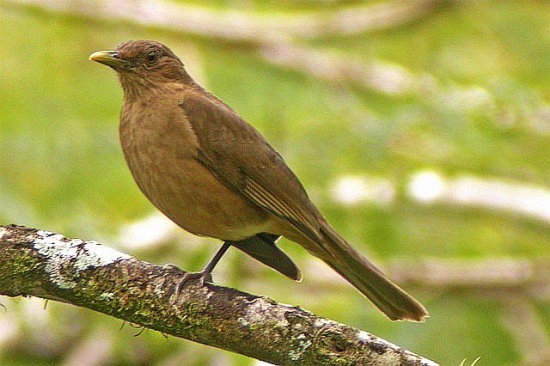m (Clay-colored Robin moved to Clay-colored Thrush) |
|||
| Line 1: | Line 1: | ||
'''Alternative name: Clay-colored Robin''' | '''Alternative name: Clay-colored Robin''' | ||
| − | [[Image: | + | [[Image:Clay-colored_Thrush.jpg|thumb|550px|right|Photo of subspecies ''casius'' by {{user|rb_stern|rb_stern}} <br />Location: El Valle, [[Panama]] ]] |
;[[: Category:Turdus|Turdus]] grayi | ;[[: Category:Turdus|Turdus]] grayi | ||
==Identification== | ==Identification== | ||
Revision as of 16:49, 17 June 2012
Alternative name: Clay-colored Robin
- Turdus grayi
Identification
23–27 cm
- Brown
- Paler underparts, lighter flanks
- Streaked throat
- Greenish-yellow bill
- Pinkish (or flesh-colored) legs
- Red iris
Females a little larger than males
Distribution
North, Central and South America
North America: found only in Texas
Central America: Mexico, Guatemala, Belize, El Salvador, Honduras, Nicaragua,
Costa Rica and Panama
South America: Colombia
South Texas, Mexico, northern Colombia, and Costa Rica.
Taxonomy
Subspecies
Six subspecies are recognized[1]:
- T.g. tamaulipensis:
- Tropical eastern Mexico (southern Tamaulipas to Yucatán Peninsula and northern Chiapas)
- T.g. microrhynchus:
- Eastern Mexico (Santa María del Río region of San Luis Potosí)
- T.g. grayi:
- Eastern Mexico (Sierra Madre Oriental) to Guatemala
- T.g. megas:
- Western Guatemala to Nicaragua
- T.g. casius:
- Costa Rica to north-western Colombia (north-western Chocó)
- T.g. incomptus:
- Coastal northern Colombia (Barranquilla to Santa Marta Peninsula)
Subspecies incomptus along with lanyoni, yucatanensis and linnaei are not recognised by all authorities[2].
Habitat
Widespread in a variety of habitats including evergreen tropícal forests and forest edges, garden lawns, shrubs and pastures.
Behaviour
Diet
The diet includes fruit and invertebrates.
Breeding
Its nest is a cup made from grass, moss, and mud. 1-3 pale blue, red-brown and grey marked eggs are laid with the average above to, but it is only the rare pair that fledges more than two young. It sometimes produces 2 broods.
At the local level, singing is highly synchronized, but at the regional level, timing of breeding can vary between one location and the next.
References
- Clements, JF. 2010. The Clements Checklist of Birds of the World. 6th ed., with updates to December 2010. Ithaca: Cornell Univ. Press. ISBN 978-0801445019. Spreadsheet available at http://www.birds.cornell.edu/clementschecklist/Clements%206.5.xls/view
- Morton & Stutchbury (2001): Behavioral Ecology of Tropical Birds. Academic Press. ISBN 0-12-675556-6
- Wikipedia
Recommended Citation
- BirdForum Opus contributors. (2024) Clay-colored Thrush. In: BirdForum, the forum for wild birds and birding. Retrieved 23 April 2024 from https://www.birdforum.net/opus/Clay-colored_Thrush




